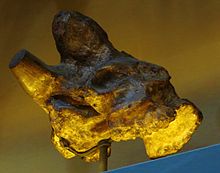Bramatherium
| Bramatherium | |
|---|---|
 | |
| Bramatherium perimense skull | |
| Scientific classification | |
| Domain: | Eukaryota |
| Kingdom: | Animalia |
| Phylum: | Chordata |
| Class: | Mammalia |
| Order: | Artiodactyla |
| Family: | Giraffidae |
| Genus: | †Bramatherium Falconer, 1845 |
| Species | |
| |
Bramatherium (Brahma’s beast) is an extinct genus of giraffids that ranged from India to Turkey in Asia. It is closely related to the larger Sivatherium.
Etymology[edit]

The first part of the generic name, Brahma (Sanskrit masculine brahman-, nominative brahmā ब्रह्मा), is in reference to the Hindu god of creation. The second part, "therium", comes from the Greek word θηρίον (transliterated therion), meaning 'beast'.
Description[edit]
Bramatherium was built very similarly to Sivatherium. Alive, it would have resembled a heavily built okapi and had a crown-like set of four, radiating ossicones. Fossils, and examination of teeth in particular, suggested the living animals dwelled woodlands and wetlands.[2]
See also[edit]
References[edit]
- ^ Geraads, Denis, and Erksin Güleç. "A Bramatherium skull (Giraffidae, Mammalia) from the late Miocene of Kavakdere (Central Turkey). Biogeographic and phylogenetic implications." Mineral Res. Expl. Bul 121 (1999): 51–56.
- ^ Khan, M. A., Akhtar, M., & Irum, A. (2014). Bramatherium (Artiodactyla, Ruminantia, Giraffidae) from the middle Siwaliks of Hasnot, Pakistan: biostratigraphy and palaeoecology. Turkish Journal of Earth Sciences, 23(3), 308-320. Retrieved from https://www.tandfonline.com/doi/abs/10.1080/02724634.2021.1898976
- Falconer, H. (1845) “Description of some fossil remains of Deinotherium, Giraffe, and other mammalia, from Perim Island, Gulf of Cambay, Western Coast of India”, J. Geol. Soc., 1, 356–372.


 French
French Deutsch
Deutsch